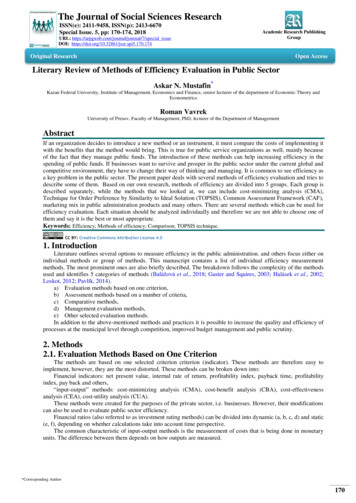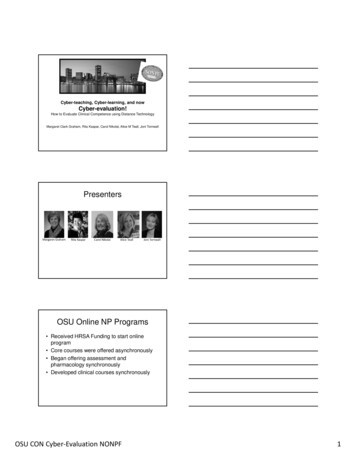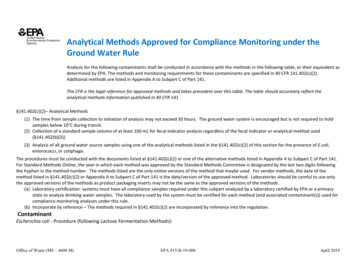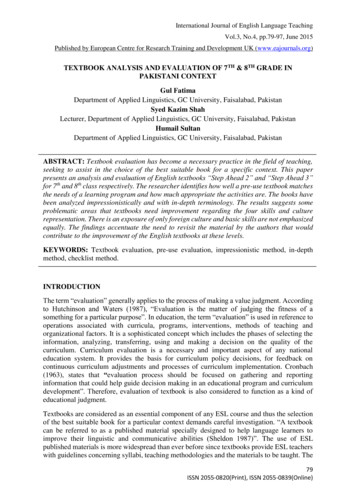
Transcription
Training Evaluation Framework and Tools (TEFT)www.go2itech.org/resourcesStep 5: Choose Evaluation Design and MethodsTool: Design and Methods Example TablesIntroduction:At this stage, you have reviewed the Training EvaluationFramework (Step 1), thought about your situational factors(Step 2), completed the Evaluation Considerations Tool (Step3), refined your evaluation questions, and begun to identifyindicators (Step 4). You now have a good idea of the outcomesyou intend to evaluate and the factors that may influence yourevaluation.This step will help you choose an evaluation design that fitsthe goals and objectives of your evaluation. It will also helpyou identify and choose between the many quantitative andqualitative methods available.Design and MethodsDesign refers to the overall structure of theevaluation: how indicators measured for theintervention (training) and non-intervention (notraining) conditions will be examined. Examplesinclude: Experimental design Quasi-experimental design Non-experimental designMethods refer to the strategies that are used tocollect the indicator data.Examples include: Pre- and post-knowledge testing Survey ObservationNote that the purpose of this section is to briefly introduceyou to a few key evaluation designs and methods specificallyexpertise, as you plan your evaluation it may be useful toused in training evaluation. It is not a comprehensive reviewinvolve another evaluator with advanced training in evaluationof research design and methods. Regardless of your level ofand research design and methods. Whether you are a highlyStep 5: Evaluation Design and Methods v.31 of 16
Training Evaluation Framework and Tools (TEFT)www.go2itech.org/resourcesexperienced evaluator or new to the field, input from anotherChoosing Your Evaluation Methods:expert can be useful as you finalize the training evaluationdesign and methods you’ve chosen. Your colleague can alsoassist you as you plan, develop tools, and implement theevaluation, and may help you plan for final analysis and reportwriting.After spending some time on the Evaluation ConsiderationsTool and thinking about your program’s evaluation resourcesand sources of readily available data, begin to think about thepossible methods that you might use to collect data on theindicators you’ve chosen.Choosing your evaluation design and methods is a veryimportant part of evaluation planning. Implementing strongdesign and methods well will allow you to collect high qualityand relevant data to determine the effectiveness of yourThe table below outlines some methods you might use,selected because they are among the most common in theliterature regarding training outcomes.training program. Without good data, it’s impossible to infer aNote again that although the TEFT is presented as a series oflink between training and outcomes.steps, in reality, the process of thinking about evaluationYour choice of design and methods will be influenced by thesituational factors and considerations you addressed in Steps2 and 3, and may help to mitigate the problems or potentialconfounders that you identified.design and methods may not follow a straight line. It mayinstead be an iterative process, in which you come up with anidea and need to revisit previous steps, to see if it makessense. For example, you might prefer to think about designbefore thinking about methods; this would work just as well.Step 5: Evaluation Design and Methods v.32 of 16
Training Evaluation Framework and Tools (TEFT)www.go2itech.org/resourcesTable 1. Possible Methods and Data Sources for Outcome Evaluation Methods, ToolsData SourcesWritten/oral responses:Training nterviewsjournalsPatientsTrainees’ co-workers,supervisors, and othercontactsGroup feedback: focus groupsTrainees, co-workers,supervisors, patients,stakeholdersType of Data CollectedContent knowledgeAttitudes, feelingsSelf-reports of trainees’ behaviorReports of perceived outcomesReports of provider behaviorSelf-report of patient understandingSelf-report of patient feelings/behaviorSelf-report of patient health statusReports of trainees’ behaviorReports of perceived outcomesPerceptions regarding programsPerceptions regarding needsPerceptions regarding outcomes, changes notes, checklistsTrained observersDocument review, data extractionRecords, documentsInstitutional/clinical recordsStep 5: Evaluation Design and Methods v.3Observations of trainee behavior in the classroom or asimulated work settingObservations of trainee performance on the jobPatient health dataProvider, organization, or population-level performancedata3 of 16
Training Evaluation Framework and Tools (TEFT)www.go2itech.org/resourcesChoosing Your Evaluation Design:You will need to choose a design that balances feasibility withcompare data for the intervention (training) with the non-an ability to help you infer a causal link between the trainingintervention (no training).and the outcome. In order to infer causality, you will need toTable 2: Possible Designs for Outcome EvaluationDesign TypeExamples Randomized controlled trial (RCT) Compares intervention with o Pre-post design with a randomizedcontrol group is one example of annon-interventionRCT Uses controls that arerandomly assignedExperimental:Quasi-Experimental: Compares intervention withnon-intervention Pre-post design with a nonrandomized comparison group Uses controls or comparisongroups that are not randomlyassignedStep 5: Evaluation Design and Methods v.3StrengthsChallengesCan infer causality withhighest degree ofconfidence Most resource-intensive Requires ensuring minimalextraneous factors Sometimes challenging togeneralize to “real world”Can be used when youare unable to randomizea control group, but youwill still be able tocompare across groupsand/or across timepoints Differences betweencomparison groups mayconfound Group selection critical Moderate confidence ininferring causality4 of 16
Training Evaluation Framework and Tools (TEFT)www.go2itech.org/resourcesTable 2: Possible Designs for Outcome EvaluationDesign TypeNon-Experimental: Does not use comparison orcontrol groupExamplesStrengths Case control (post-interventiononly): Retrospectively comparesdata between intervention andnon-intervention groups Pre-post with no control: Data fromone group are compared beforeand after the training interventionSimple design, usedwhen baseline dataand/or comparisongroups are not availableand for descriptivestudy.Challenges Minimal ability to infercausalityMay require leastresources to conductevaluation.As you think about these options, it is very useful to consultreviewing the process of collecting the data and the resourceswith colleagues to get feedback on your proposed evaluationthat will be required to do this. Think about whether your planlevel, questions, indicators, design, and methods. It will alsowill answer your questions, is feasible, and makes good use ofbe useful to “walk though” the evaluation in your mind,your resources.Step 5: Evaluation Design and Methods v.35 of 16
Training Evaluation Framework and Tools (TEFT)www.go2itech.org/resourcesEvaluation Designs and Methods—examinations, and clinical data review. For your reference, theExamples from Published Literature:corresponding literature is cited in the last page of thisdocument. A full list of articles reviewed for the developmentLiterature already published on training outcome evaluationof this framework is also available on the TEFT website.provides some valuable insight into evaluation design andmethodology. The examples below explore evaluation designsEvaluating Outcomes at the Individual Level:and methods that have been reported at the three levels ofThe examples in Table 3* present methods and designs fromthe Training Evaluation Framework: individual, organizational,and systems/population (Figure 1). Presented here areexamples of experimental, quasi-experimental, and nonexperimental designs and a range of methods, includinginterview, focus group, observation, written surveys andpublished articles. These articles reported on the effect oftraining on individuals. As indicated in the Training EvaluationFramework, changes that could be evaluated include newknowledge, skills, and/or attitudes among the trainingparticipants, changes in their on-the-job performance (as aresult of this new knowledge), and changes in patient healthKeep an open mindKeep in mind that there is no single best designor best method; all designs and all methods arepossibilities for each outcome level andcategory. Your choices will depend upon theoutcomes you evaluate, the situational factorsyou identified in Step 2, and the considerationsyou addressed in Step 3.Step 5: Evaluation Design and Methods v.3(as a result of improved health care worker performance). Themajority of training evaluations which have been reportedwere conducted at this point in the causal pathway towardbetter health outcomes.*Notice that in the table, all outcomes are in color. The color of the textcorresponds to its place in the framework. So, for example, the outcome“skills and attitudes of health care workers” is purple, because on theframework, outcomes of this type are in the purple arrow.6 of 16
Training Evaluation Framework and Tools (TEFT)www.go2itech.org/resourcesFigure 1: Training Evaluation FrameworkStep 5: Evaluation Design and Methods v.37 of 16
Training Evaluation Framework and Tools (TEFT)www.go2itech.org/resourcesTable 3. Evaluation Designs and Methods for Measuring Changes at the Individual Level1. Randomized Controlled Trial: An experimental design in which the individuals being studied(e.g., training participants) are randomly assigned to either an intervention condition or a controlcondition.ExamplesDesign and MethodsArmstrong et al (2012)1:Outcomes evaluated: Skills and attitudesAn evaluation of theoutcomes of a 15-hourtraining intervention aimedat providing social workerswith cognitive behavioralstrategies for work in theprimary mental health caresetting.How the evaluation was designed:Forty social workers were randomly assigned to either an intervention condition (20 received thetraining), or a control condition (20 did not receive the training).How the data were collected:Observation using expert observers “blind” to whether the trainees received or did not receive thetraining intervention. Observers scored videotaped sessions of simulated counseling sessions conducted pre-trainingand 1 week post-training.Scoring was based on a validated measure of competencies related to the training.Self-report of confidence was measured using a questionnaire. Participants rated their confidence in applying the trained methods on 5-point scales.2. Pre- and Post-Intervention with Control: A quasi-experimental design in which trainees are assigned toeither an intervention or control condition, but they are not randomly assigned. Measures are taken beforeand after the intervention in both the training group and control group (non-randomized) to compareeffects of the intervention.ExamplesDesigns and MethodsKumar et al (2009)2:A conventional 8-dayOutcomes evaluated: Knowledge and skillsStep 5: Evaluation Design and Methods v.38 of 16
Training Evaluation Framework and Tools (TEFT)www.go2itech.org/resourcesintegrated management ofneonatal and childhoodillness training package wascompared to a 5-daytraining package that wasdeveloped andadministered in aninterrupted mode of 3 daysand 2 days duration with abreak of 4 days in between,in a district of Haryana statein northern India.How the evaluation was designed:Primary health care workers were assigned to either an intervention condition (conventional 8-daytraining), or a control condition (interrupted 5-day training).How the data were collected:Pre-post questionnaire: A multiple choice questionnaire was administered before and after the trainingto assess participant knowledge.Case studies: Video case demonstrations pre- and post-training were used to assess clinical decisionmaking skills.Observation: Observers rated trainees on performance in role plays and conducting simulated clientexaminations using skills observation checklists.3. Pre- and Post-Intervention with No Control: A non-experimental design in which data are collectedbefore and after a training to see whether changes occurred. Because of possible confounders, this designlimits the ability to conclude that the intervention caused any changes seen, but findings can be suggestiveof causality.ExamplesDesigns and MethodsAkweongo et al (2011)3:In 5 African countries(Burkina Faso, Ethiopia,Ghana, Kenya, and Malawi)a malaria preventiontraining program wasimplemented amongcommunity medicinedistributors (CMDs). CMDswere trained to educatecaregivers, and to diagnoseand treat malaria cases in 5-year olds.Outcomes evaluated: Provider performance and health outcomes (patient knowledge is included inhealth outcomes category)How the evaluation was designed: Data were collected before and 1 year after the CMDs were trained, inorder to assess the effect of the training upon treatment practices and patient attitudes regarding careprovision by CMDs.How the data were collected:Records review: Registers kept by CMDs were reviewed and data extracted.Household surveys: Surveys were administered to households to assess treatment provided.Focus group discussions and in-depth interviews: Patients (parents of pediatric patients) andcommunity stakeholders participated in focus group discussions to determine perceptions related tomalaria care and treatment.Step 5: Evaluation Design and Methods v.39 of 16
Training Evaluation Framework and Tools (TEFT)www.go2itech.org/resources4. Case-Control: A non-experimental design in which data are analyzed retrospectively for 2 groups ofsubjects: a group which had the training intervention, compared with a group that did not have theintervention.ExamplesDesigns and MethodsIdigbe et al (2006)4:In Nigeria, a study wasconducted to determine theeffectiveness of a nationalantiretroviral trainingprogram.Outcomes evaluated: Knowledge , skills and performanceHow the evaluation was designed: This was a study in which data for a sample of the health care workerswho had received the national training (and who were randomly selected after a pool of potentialevaluation subjects was compiled) were compared with that of a group of untrained health personnel frominstitutions where no personnel had received the trainings. The data were collected at one time point,between 6 and 9 months after the trainees had received the training.How the data were collected:Pre-post knowledge questionnaires: Knowledge questionnaires were completed by trainees andsubjects in the comparison groups to assess content knowledge related to the national ART trainingprogram.Patient exit surveys: Clients were surveyed as they exited their appointments to assess theirperceptions regarding the quality of care that they received.In-depth interviews: Heads of ART units were interviewed with regard to their units’ management,strengths and weaknesses, and how these might affect the performance of the trained health workers.Focus group discussions: Trainees participated in focus groups to explore their perceptions of thetraining and its effects on their skills and the quality of services in the antiretroviral treatment clinics.Observation checklist: Observers used a checklist to inventory facility resources and systems, includingavailable drugs, laboratory equipment, human resources, and supplies.Step 5: Evaluation Design and Methods v.310 of 16
Training Evaluation Framework and Tools (TEFT)www.go2itech.org/resourcesEvaluating Outcomes at the Organizational Level:There are also many examples of research designs andorganizational performance, and changes in patient healthmethods used for evaluating the effect of training at theoutcomes at an organization. Table 4 presents some researchorganizational level. As illustrated in the Training Evaluationdesigns that have been used to measure training effect onFramework (Figure 1), these changes include improvements inorganizations, along with the corresponding literature citedhealth systems at the organizational level, changes infor each type of outcome.Table 4. Evaluation Designs and Methods for Evaluating Changes at the Organization Level1. Pre-Post Time Series: A non-experimental design in which the indicators of change were tracked overmultiple time points before, during, and after the intervention.ExamplesDesign and MethodsKayongo et al (2006)5:In a large hospitalimprovement project inRwanda, CARE and partnerorganizations implemented amulti-component interventionto improve emergencyobstetric care. In addition totraining of staff, the hospitalwas renovated, essentialequipment was provided andquality improvement projectswere introduced.Outcomes evaluated: Systems changes and facility-level provider performanceHow the evaluation was designed: The evaluation was incorporated into a comprehensive improvementproject which tracked project progress weekly as well as analyzing indicator data yearly over 4 years.How the data were collected:Step 5: Evaluation Design and Methods v.3Patient interviews: Patients were interviewed regarding their experiences with clinical servicesduring a baseline assessment conducted to develop intervention plans.Progress notes: Progress of improvement projects were tracked with weekly meetings.Records review: Registers kept by facilities were reviewed and data extracted for several indicatorsrelated to emergency obstetric care. These were analyzed and tabulated yearly over a period of 4years.11 of 16
Training Evaluation Framework and Tools (TEFT)www.go2itech.org/resources2. Cluster Randomized Controlled Trial: A design in which clusters of health facilities are randomly assignedto either an intervention condition (facilities where providers received the training) or a control condition(facilities where providers did not receive the training).ExamplesDesigns and MethodsGilroy et al (2004)6:In Mali, the impact of IMCI(Integrated Management ofChildhood Illness) training onthe quality of counselingprovided to parents of sickchildren was evaluated.Outcomes evaluated: Skills and PerformanceHow the evaluation was designed:Cluster randomized controlled trial: Ten community health centers in southern Mali were randomlyassigned to either the training group or the comparison group.How the data were collected:Observation: Health providers’ consultations with pediatric patients’ caregivers were observed bytrained observers using a 10-point scale related to counseling behaviors.Interviews: Patients’ caregivers were interviewed using structured questionnaires to collect sociodemographic, literacy and language data.3. Three-Arm Cluster Randomized Controlled Trial: A design in which clusters of health facilities wererandomly assigned to one of three conditions: an intervention condition (facilities where providers receivedone version of the training), a second intervention condition (facilities where providers received a differentversion of the training), or a control condition (facilities where providers did not receive the training).ExamplesDesigns and MethodsNgasala et al (2008)7:In Tanzania, the impact oftraining in microscopy-baseddiagnosis of childhood malariawas assessed at primary healthOutcomes evaluated: Performance and health outcomesHow the evaluation was designed: 16 health facilities in southern Tanzania were randomly assigned toone of three training groups: training in clinical algorithm plus microscopy (Arm-I), or clinical algorithmonly (Arm-II), or to no training (Arm-III).Step 5: Evaluation Design and Methods v.312 of 16
Training Evaluation Framework and Tools (TEFT)www.go2itech.org/resourcescare facilities.How the data were collected:Records review: Demographic and patient health data were collected for patients. The primaryoutcome indicator was the proportion of eligible patients receiving prescriptions of antimalarialdrugs. Secondary outcomes included prescriptions of antibiotics, cost of drugs and the proportion ofpatients reporting symptoms following treatment. The cost of drugs was calculated using price listfrom Medical Store Department.Interview: At the end of the study, interviews were conducted with health care workers in Arm-I toassess whether and under what circumstances they prescribed antimalarial treatment to patientswith negative blood smear results.Evaluating Outcomes at the Health Systems/changes at this level include improvements in national andPopulation Level:regional health systems, and changes in health care workerperformance and patient health outcomes at the populationIn the published literature reporting outcomes of health careand community levels. Table 5 presents some research designsworker training programs, the proportion of examples at thethat have been used to measure training effect on healthhealth systems/population level is the smallest of the 3 levels.systems and populations, along with the correspondingAs illustrated in the Training Evaluation Framework (Figure 1),literature cited for each type of outcome.Step 5: Evaluation Design and Methods v.313 of 16
Training Evaluation Framework and Tools (TEFT)www.go2itech.org/resourcesTable 5. Evaluation Designs and Methods for Evaluating Changes at the Health System/Population Level1. Pre- and Post- Intervention with Comparison PopulationIn this quasi-experimental design, populations are assigned to either an intervention or control condition,but they are not randomly assigned. Measures are taken before and after the intervention in both theintervention group and the comparison group (non-randomized) to compare effects of the intervention.ExamplesMarsh et al (2004)8:A study conducted in ruralKenya was designed toevaluate the effect of atraining program for drugretailers to sell early effectivetreatment for malaria.Design and MethodsOutcomes evaluated: PerformanceHow the evaluation was designed: The implementation of the training intervention was implemented ina phased manner. Communities which received the training in the first phase (early-implementationareas) were compared to communities which received the training in the later phase (lateimplementation areas). This evaluation design also provided before-training and after-training data forboth the early-implementation and the late-implementation areas.How the data were collected:Household surveys: Households within each area were surveyed regarding their over-the-countermalaria drug use.Observation: Simulated client visits to trainees were conducted, using a standardized scenario andsimple assessment checklist of retailers’ skills in responding to requests for over-the-countermedication to treat a child with a fever.2. Cluster Randomized Controlled Trial (Population-level): A design in which clusters of communities orpopulations are randomly assigned to either an intervention condition (communities where providersreceived the training) or a control condition (communities where providers did not receive the training).ExamplesDesigns and MethodsBhandari et al (2002)9:Outcomes evaluated: HealthHow the evaluation was designed:Step 5: Evaluation Design and Methods v.314 of 16
Training Evaluation Framework and Tools (TEFT)www.go2itech.org/resourcesA training evaluation wasconducted to measure theeffectiveness of aneducational intervention topromote adequatecomplementary infant feedingpractices. Health and nutritionworkers in the interventioncommunities were trained tocounsel on locally developedfeeding recommendations.Cluster randomized controlled trial: Eight communities in rural Haryana, India were matched based onsocioeconomic indicators, child mortality and morbidity rates. The communities were then randomlyassigned to either the training group or the comparison group.How the data were collected:Home visits: Newborns were enrolled in all of the communities and followed up with home visitsevery 3 months to the age of 18 months. Follow-up data collected in home visits included weight andlength of the infants as well as dietary intake.3. Pre- and post-Intervention with No Control: A non-experimental design in which the indicators of changewere tracked over 2time points: before and after the training intervention.ExamplesDesigns and MethodsCarlo et al (2010)10:Outcomes evaluated: Performance and HealthA multi-country study,conducted in Argentina,Democratic Republic of theCongo, Guatemala, India,Pakistan, and Zambia, soughtto evaluate a train-the-trainermodel for training birthattendants living in rural areasin the WHO EssentialNewborn Care (ENC) course.How the evaluation was designed: This was a before-and-after intervention design conducted in 6countries. Data collection for this study preceded a later study of further training, which was designed asa randomized, controlled trial.How the data were collected:Step 5: Evaluation Design and Methods v.3Medical records data extraction: Reviews of hospital and clinic records were done, and data wereextracted for comparison between pre- and post-training time points. Performance indicatorsincluded use of resuscitation techniques. Health indicators included Apgar scores, birth weight, andmaternal and neonatal deaths.15 of 16
Training Evaluation Framework and Tools (TEFT)www.go2itech.org/resourcesSummaryRemember that there is no single best design or best method,and that all designs and all methods are possibilities for eachChoosing your evaluation design and methods is a veryimportant part of evaluation planning. Your choice of designand methods will be key factors in collecting high quality dataoutcome level and category. Your choices will be influenced bythe indicators you wish to track, the intended use of theevaluation findings, and the resources available for evaluation.which may, in turn, allow you to infer a link between trainingand outcomes. The examples presented in this documentillustrate a number of the options you may choose from.References1. Armstrong G et al: An evaluation of the effect of an educational intervention for Australian social workers on competence indelivering brief cognitive behavioural strategies: A randomised controlled trial. BMC Health Services Research 2010, 10(1): 304.2. Kumar D et al: The effect of interrupted 5-day training on Integrated Management of Neonatal and Childhood Illness on theknowledge and skills of primary health care workers. Health Policy and Planning 2009, 24:94-100.3. Akweongo P et al: Feasibility and acceptability of ACT for the community case management of malaria in urban settings in fiveAfrican sites. Malaria Journal 2011, 10:240.4. Idigbe E et al. Evaluation of the Nigerian national antiretroviral (ARV) treatment training programme. Sahara J 2006, 3:488-502.5. Kayongo M et al: Improving availability of EmOC services in Rwanda--CARE's experiences and lessons learned at Kabgayi ReferralHospital. Int J Gynaecol Obstet 2006, 92(3):291-298.6. Gilroy P et al: Impact of IMCI training and language used by provider on quality of counseling provided to parents of sick children inBougouni District, Mali. Patient Education and Counseling 2004, 54(1):35-44.7. Ngasala B et al: Impact of training in clinical and microscopy diagnosis of childhood malaria on antimalarial drug prescription andhealth outcome at primary health care level in Tanzania: a randomized controlled trial. Malar J. 2008 7:199.8. Marsh V et al: Improving malaria home treatment by training drug retailers in rural Kenya. Trop Med Int Health 2004, 9(4):451-460.9. Bhandari N et al: An educational intervention to promote appropriate complementary feeding practices and physical growth ininfants and young children in rural Haryana, India. India J Nutr 2004, 134(9):2342-8.10. Carlo W et al. Newborn-Care Training and Perinatal Mortality in Developing Countries. N Engl J Med 2010, 362: 614-23.Step 5: Evaluation Design and Methods v.316 of 16
Step 5: Evaluation Design and Methods v.3 4 of 16 Choosing Your Evaluation Design: You will need to choose a design that balances feasibility with an ability to help you infer a causal link between the training and the outcome. In order to infer causality, you will need to compare data for the intervention (training) with the non-










